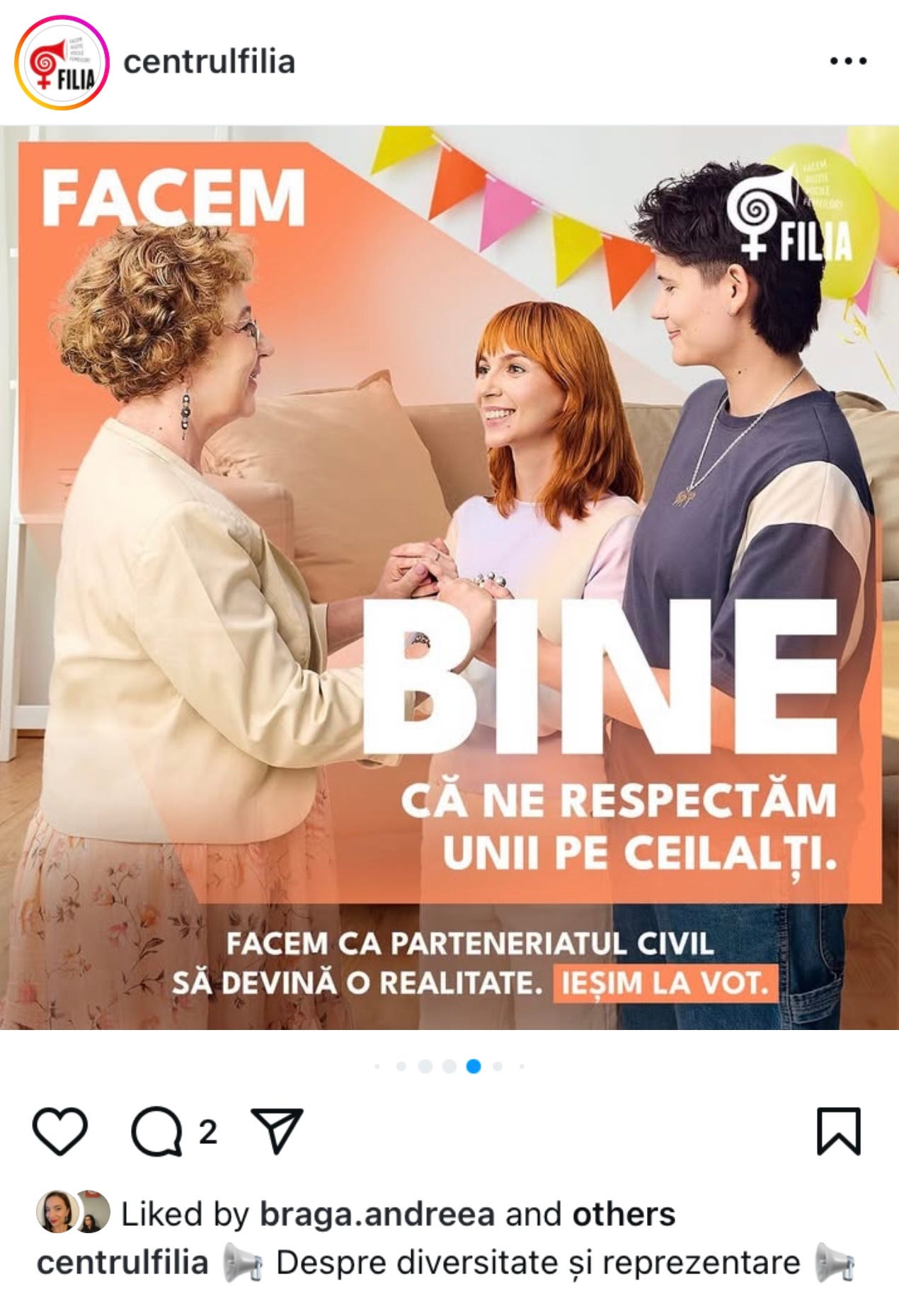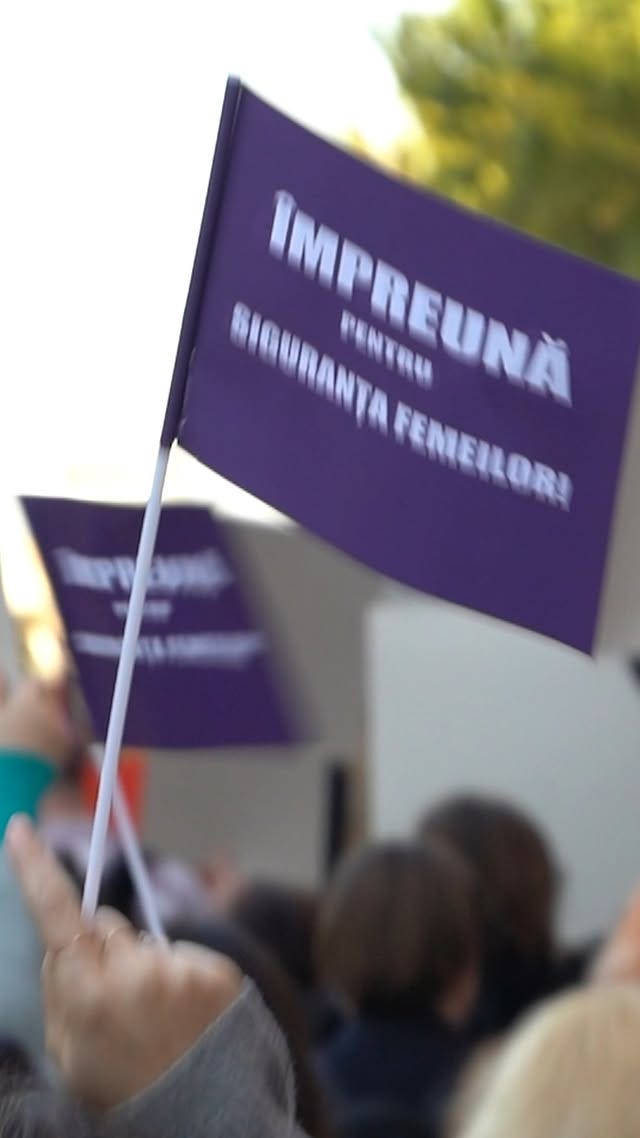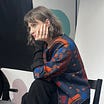How to Hope #1: When Care Becomes a Political Act
How Romania's biggest women's rights group transformed their campaigning with hope
This is the first interview in How to Hope: a series of interviews with people using the hope-based approach.
Faced with the rise of far-right parties and a backlash against hard-won gains for women’s rights, Romanian women’s rights group Centrul FILIA held a hope-based workshop in early 2024. Here, I talk to Cristina Praz, Gender Equality and Communications Specialist, about how they used the hope-based approach for the rest of the year.
They saw record participation at the annual march for Women’s Safety and ran a hope-based GOTV campaign - Facem Bine (We are doing good / Doing Good) - that reached 2 million people.
This really is a special campaign that shows how to inject hope into really difficult issues. It shows how intrinsic values can drive campaigning, by explicitly tying the act of care in daily life to the act of voting as a broader act of care for society as a whole.
I spoke to Cristina about how they developed the campaign and the wider impact using a hope-based approach has had on her work. We also talked about last weekend’s election results where the liberal candidate defeated the far-right.
How to Hope: When Care Becomes a Political Act
Summary: In Romania, feminist group FILIA used a hope-based approach to triple their protest turnout, create the country’s first inclusive voting ad, and connect daily acts of care with civic power. Here, Cristina Praz explains how hope helped them reclaim space from the far-right—without ignoring the harm women face.
Holding hope and suffering together
Thomas Coombes (TC): Cristina, let's start at the beginning: what was your first reaction to hope-based communication when we held a workshop for Centrul Filia last year? I remember that like many people who really embrace the hope-based approach, you raised some tough questions.
Cristina Praz (CP): At first, I had doubts. I work on gender-based violence, which is a very sensitive issue. My concern was about presenting women's stories authentically. I didn’t want to say everything is fine when clearly, for many women, it isn’t. But my "aha" moment came when I understood that hope-based communication gives women the choice to speak about their experience and believe their voices matter: that getting involved offers a chance to do something.
Changing how we think: Integrating hope
TC: How did you start practically applying this insight?
CP: We began very simply, by adding hope to our social media posts. With extremist parties gaining power and visibility, you could see the hate in rising in society.
Sometimes it was also hard for us to find the hope in our hearts. We started by adding small phrases to social media posts showing people how they can act. It was the first change that we did in our communication.
Showing how society really is - the Do Good campaign
TC: Cristina, the most exciting thing for me is the way in the workshop the whole team coalesced around the value of care, both as a value we need to reinforce, but also as something to drive in politics too. How did you bring that idea to life with your values-based Do Good campaign you ran around the Romanian elections at the end of 2024?
We wanted to get women to vote, but also to be more active in the civic part of their lives. We've seen that women - especially older women - are socialized by the society around them to feel that their opinions, their needs are not so important. It was quite a struggle at the beginning but in the end we managed to create one of - no, my favourite ever campaign video.
It features real, diverse couples and families from different social backgrounds: Roma families, a lesbian couple, women both young and old. We wanted to show that there are very different people with different needs in our society, but those people are just like everyone else: they just want to be fine and to love whoever they want to love.
We realized afterwards that actually it's the first national video campaign that we know of that was so inclusive, that you had different ethnicities, different genders, ages, different orientations.
It counters the far-right by saying, ‘We will not be afraid to show diversity in our campaigns just because they are saying it is bad or I don't know what. So we managed to have our own narrative and not to let them decide for us.’
The power of feeling seen
TC: How was the campaign received?
CP: I feel like we had a lot of positive reactions, but one of the most positive that touched me most came from among our volunteers.
We heard from lesbian couples who said that it was the first time that they felt represented and seen in Romanian content.
They are not yet open to their families, friends or colleagues yet. And they were really moved by their representation, because even in the LGBT community, the lesbian women are not as visible as, for example, gay men.
So for us, it was really important to have a lesbian couple also in the idea that women in their diversity are there and they need to be appreciated and protected. And it was very difficult to find a real lesbian couple due to the stigma and discrimination they face.
It was very powerful to me because of this idea that just by seeing somebody that resembles you in a video brings you so much power. It made me feel we did the right thing with this approach.
TC: That story is really moving. you remind me why we had this victim to human shift in the first place. It's so easy to forget just the power for people of seeing themselves. And I wonder if that's, again, something that's more possible that we achieve when we do it through that human frame.
“Doing good” should be good politics
TC: And it is so telling that you got there by focusing on your values.
CP: Yes, it was very intentional. We put a lot of work to actually gather real people rather than use actors because we wanted to be authentic. We wanted to show them, okay, this is how society actually looks.
The campaign was called "We Are Doing Good" (Facem Bine). The idea was that small acts of love: are political acts
And we tied everyday actions to political change. For example, a mother teaching her son about consent can also vote for parties that support consent laws. It's about showing how our values show up in daily life.
That was actually a way of showing how little acts of good transform into bigger political acts and social policies. For example, by, I don't know, you as a grandma, by going to dinner with your niece who is a lesbian and you are having dinner all together, you are doing good.
And by supporting a party that protects same-sex couples, you are doing also good. Small acts of love are political. It really is that simple.
Just by loving and supporting your neighbor, no matter their orientation, gender, ethnicity, by loving them and supporting them and being there for them, you are doing a political act already.
Because we know that everything is political and that it doesn't have to be so complicated as they make it seem. Politics doesn't have to be something so big, because love is the easiest and the most warming thing you can do in your life - just showing love.
Our version of care
TC: And I think one of the things that makes the campaign also very universal, actually, is, again, you did this very hard work of showing your values in action, basically. And so I think let's go back a bit to how we got there, because I remember we did our workshop and we focused a lot on this idea of care and what does care look like?
I remember the idea of care as both personal and political value came out very strongly from our workshop. But then the challenge you had was how to show “care” as a value without reinforcing traditional images of care, like a mother giving her child a school lunchbox.
CP: Yeah. We didn’t just want to show a mother making the school lunch. So we filmed a Roma father kissing his daughter before school (again, featuring a real couple). That small act told a bigger story: care isn’t gendered, it’s human.
TC: It’s fascinating to see how much sophistication and balance and well, care, went into showing this version of care that you wanted to show.
CP: Yes, whoever is saying that hope-based communication is the simple way, I disagree. There is so much nuance to pay attention to: it's like working on a wire!
Everyday action that connects values and politics
TC: You've made the connection to the everyday, to the politics. I have been thinking lately about how we make love a political force. And that's exactly what the campaign has done.
CP: The “Doing Good” message was a good opportunity to play with words in Romania, but also to show how politics is also part of everyday life, and how everything is connected.
For example we had a post about consent where a mother was talking to her son about consent and we were connecting this act to voting for parties pushing the consent laws.
And indeed, in Romania in 2024, we actually managed to bring into law a minimum age for consent. We were showing people that change starts with you being part of these things and by voting for those who want to do the same things and share the same values as you.
Our message was that politics is in your everyday life: it affects the prices you are paying for different things, where to go if you are a victim of gender-based violence, if your kids will be protected in their schools, if you have the right to marry the person you love. These are all politics and they translate in the values of the people you vote for.
TC: Do you feel this campaign translated into political impact?
CP: I think it gave politicians more courage to speak about these topics, which they are often reticent to do in such a conservative country. Progressive politicians also need support when they change the norms and challenge the status quo.
Dealing with dark issues
TC: I think one of the things you did was done really well is you always start from a very strong passion about the harm. What really stood out for me was how the campaign addressed gender-based violence of the content: showing a survivor, but then the story was also the caring for the survivor and there's someone caring for and hugging her.
(note: this was the one part of the campaign where an actor was used)
CP: We wanted to show harm: in Romania it's very difficult to be Roma, lesbian or a survivor of gender-based violence. But we wanted to show that by having the care and support that you need it's a bit easier. That you by being part of that care and support, are doing so much good to the others around you.
So we wanted to highlight the good part without erasing the the real experience but in a way that shows: just by doing like these small things of good you are actually doing a lot.
How hope changed the scale, and the feeling, of a women’s rights march
TC: Tell us about your march marking the International Day of Combating Violence Against Women in October 2024: what changed when you applied a hope-based approach?
CP: This was incredible. We focused our communication on the world we wanted: one without violence. Instead of highlighting scary statistics, we shared relatable, everyday experiences. For example, "Do you want to live in a world where you're not afraid to go out at night? Come join our march and help make it a reality." The result was remarkable: participation rose from 3,000 to 10,000 people.
But beyond the numbers, you could feel the difference during the march itself. The atmosphere was more hopeful, people were cheering. People could really feel that, okay, we are here, we can make a change, we can make things better for women in our lives. I feel that this was the most successful thing that we can hope for.
We even spontaneously created a powerful feminist song and video from the march chants. (The lyrics are the slogans chanted during the march: "Even if I am naked, you cannot touch my body unless I want you to.")
For me, it was such an amazing thing to see that as a result from our community, like people, friends or volunteers managed to record the things we were chanting and also film them. And at the end, to have this really, really powerful short video was something so community-based that really moved us to tears, honestly.
TC: Wow. That video gave me goosebumps. Was it hard to get your partners on board?
CP: I realized that we didn't have to have a heavy conversation. It became kind of natural. We shared fewer numbers in our communication. I honestly expected for people to need them, but I don't think they noticed the lack of data. Instead we focused what a society without violence looks like.
We asked, ‘Do you want to live in a world where you are not afraid to go out on the street in the evening? Okay, come to our March and help make this reality.’
Just by noticing our messaging, they naturally followed the flow. It was the power of showing, not telling.
TC: I think there's a great insight there: just talking about those values you wanted to bring, those values naturally resonated with your audience, with your colleagues, with your allies and your partners, without you actually needing to say, okay, now we're being hope-based.
Advice to other hope-based communicators: how long does narrative change take?!
TC: Any advice for others looking to adopt hope-based communication?
CP: The end goal is not always the numbers and it's the behavioral change or the attitudinal change that you want to make amongst people.
So even though a post might get fewer likes, it doesn't mean it's not working. It just means that it needs time to become more normal. So have the courage to try and give yourself some time to see the results.
TC: Yeah, I think actually you were one of the people who've asked me this question. I'm really not sure how to answer of how long does it take?
CP: But I can say that a year later, since I asked you that question, I see the results. So even though we will not see like, okay, today the society is perfect, you can still see the changes you have to a different approach.
TC: The hard part of this question is how you can deploy hope-based for immediate results in a crisis. How about that moment when the far-right surprisingly triumphed in the elections last December? [the result was later overturned by the courts because of election interference]
CP: When we had the most difficult moment in December: it was difficult for us to find that hope inside us and encourage others. But we took a moment to be vulnerable and to say, ‘OK, we do not want to spread more hate or more fear’.
So we stopped and we actually did a few posts that were very hopeful and we were saying, okay, we know that you are scared, we are also scared, the things are bad, but the answer is not to meet hate with hate. Take the time to speak with those around you that may feel different and to take care of yourself. The message was: “OK, some are going to be hateful, but we are going to choose to be loving.”
People really needed and appreciated these posts
We wanted to just give people a moment where they are feeling like a community and to encourage people to show love and care, not hate. This was a very “shifting” moment for us.
Last weekend’s election results: far-right defeated, for now
TC: And how are you feeling about the election results. Do you feel you managed to get care on the agenda?
CP: We are really moved by how people really organised to stop hate from winning. We had an impressive, historical mobilisation in all different parts of society: youth, diaspora, women and minority communities.
The pro-european candidate had a VERY hopeful communication in all his last campaigns: he spoke a lot about respect and togetherness. I could see in the online spaces that a lot of people appreciated his communication for being respectful and calm, rather than attacking the opposition.
Another nice thing we noticed that other NGOs are using "care" as a main value. This makes us feel that our campaign was successful - that the message is becoming the norm.
TC: Lastly, Cristina, can you share one fear and one hope you’re holding right now?
CP: I fear losing the rights generations of women fought for. But my hope? We are not alone—and we still choose love.


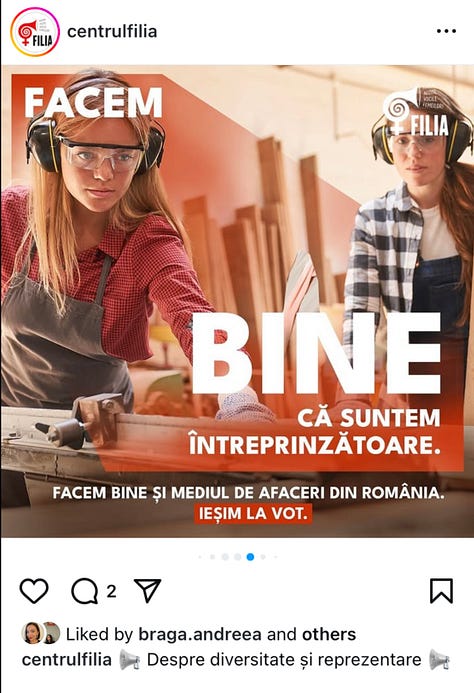
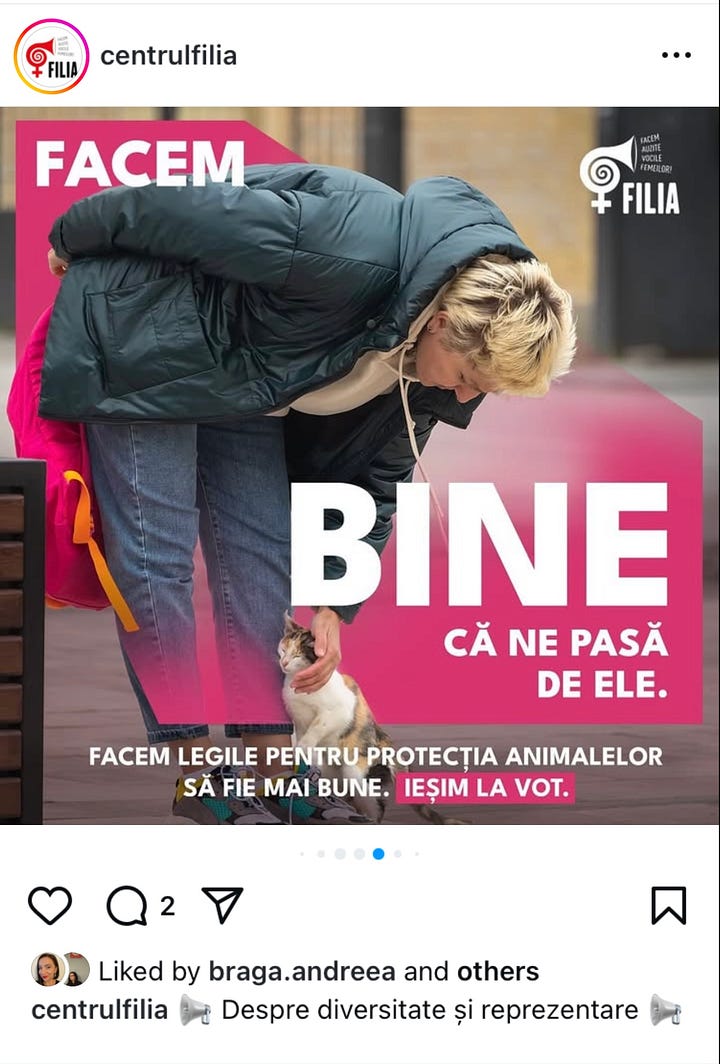

Hopey, Changey Stuff
CHECK OUT THE HOPE BOX! Very excited by this new prototype developed during the Rewire Incubator. This is one of the most exciting applications of hope-based communication so far, with many exciting potential applications.
“The hope gap is becoming one of the defining narrative challenges of our time.” - new report from the Blis Collective. It warns that people need to believe change is possible: ”It is not enough for our people to want Reparations and Land Back – we must invest in strategies that help them believe they are achievable.”
Kindness as habit/muscle/strategy. H/T Judit Costa!
Brain Science Corner
Our brains are prediction machines.
“Prediction is integral to perception … our experience depends absolutely on the work of our sugar- and oxygen-hungry brains. In other words, perception is far more dependent on prior knowledge – painstakingly created internal models of the world – than we usually take it to be.
The contemporary expert Anil Seth puts it nicely: ‘We tend to think of perception as occurring outside-in, but it mostly occurs inside-out.’”
Why this matters for social change: how we receive new information or messages is mediated by what we already know (i.e. narratives!). If we want new ideas - even our core basic beliefs - to spread, we have to make them familiar.
Quote of the week
“They heard we were trapped here and have brought us food and water. What they don’t know is that they’re bringing something more. Call it hope in humankind.”
- report from Spain during the power cuts, shared by Monica Roa.





